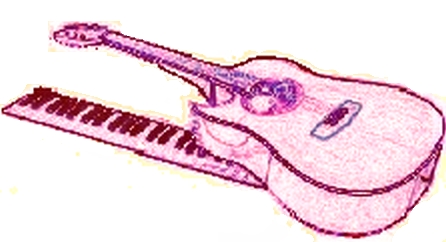Once upon a time, before CDs, tape recorders, Thomas Edison, or even player
piano rolls and music boxes, the only way to record music was to write it down. Before that, everything had to be memorized
and taught to each new generation. Not a very efficient or accurate way of preserving a piece of music. Over the course of
time, a lot was bound to be altered or forgotten.
Our modern method of music notation is not very old—only several hundred
years—which of course is a small fraction of human history. It took quite a while to perfect the system. There are musical
scores from the Middle Ages that no one really knows what they sounded like. Only the notes are indicated—no timing
or rhythm is given. That is a lot like the guitar tablature system of transcribing songs that is so popular with the kids
nowadays. Six lines on the page represent the six strings of a guitar. Numbers on those lines tell you what notes to play
but there usually isn’t any time value indicated for those notes. You have to listen to a recording of the song to get
that. Almost a throwback to the system used by the monks of the Middle Ages. Where is the progress in that?
But also today, on a home computer, with the right software, you can create
and record your own multi-instrumental composition with an ease Mozart and Beethoven could never have imagined. You basically
have an orchestra and a rock band right at your finger tips. And after producing your masterpiece, you can then burn it to
a CD or upload it to the Internet. You have now become a one-person recording artist, recording studio and label! Ain’t
technology amazing?
Still, there is a lot to be said for learning to read traditional music notation.
Besides giving you easy access to a huge library of published sheet music and songbooks, it will definitely add to your enjoyment
of music and your understanding of how to make it.
I always encourage my students to develop their music reading skills, even though
most of the music superstars that they admire probably could not recognize a single note of written music, even if it was
in one of their own hit songs!
Yes, I have known many excellent musicians who couldn’t read music, but
they all seem to regret not learning to and realize that they are missing out on an important part of making music.
I have also known musicians who couldn’t play at all unless they had sheet
music in front of them. Either extreme is not the best situation. It is better to become a well-rounded musician who can read
music but also "play by ear."
Learning to read music is not hard but a lot of people find it really difficult.
I think it’s just a mental thing. Things have a way of being the way we expect them to be. As in everything we do, beliefs
and attitudes are a big factor in learning music.
Ken May teaches piano and guitar at his studio in League City, Texas. He believes
that the many rewards gained from music lessons benefit every aspect of life. For more information, call 281-338-9920 or visit
www.kenmay.com
Copyright 2004 Ken May

